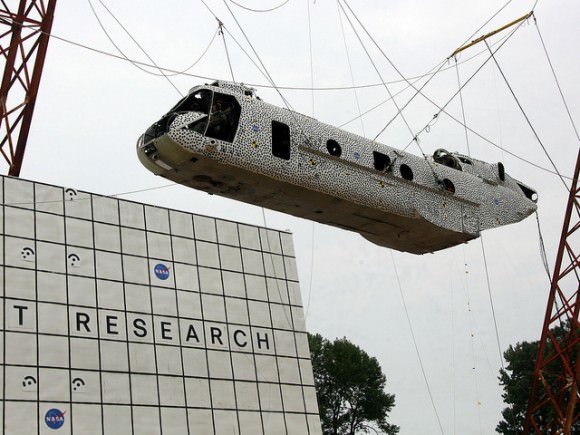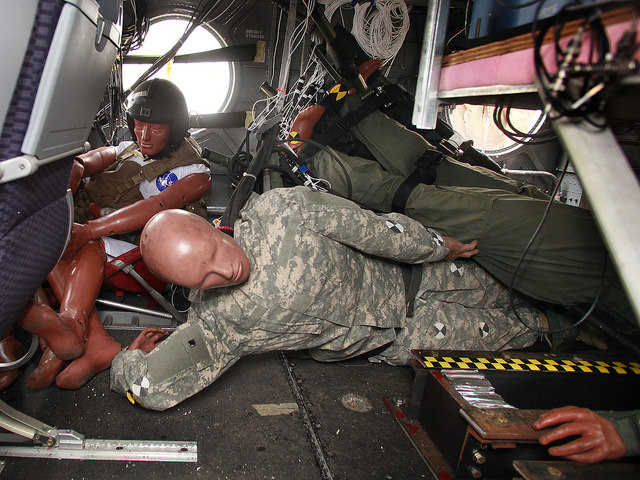Not only did NASA purposely crash a Marine helicopter today, but they also stuffed 15 crash test dummies inside for a group “crash” party and filmed the event from every angle imaginable. The crash test took place at the Langley Research Center in Hampton, Virginia and engineers dropped an old Marine CH-46E helicopter fuselage from a height of about 9 meters (30 feet), traveling at about 48 km/h (30 mph) to test improved seats and seatbelts and gather data on the odds of surviving a helicopter crash.
“We designed this test to simulate a severe but survivable crash under both civilian and military requirements,” said NASA lead test engineer Martin Annett. “It was amazingly complicated with all the dummies, cameras, instrumentation and the collaborators, but it went well.”
The fuselage hit hard, as evidenced by the video and images NASA has released. Thirteen instrumented crash-test dummies and two un-instrumented manikins had a rough ride, as did some of the 40 cameras mounted inside and outside the fuselage. Preliminary observations indicate good data collection, which will take months to analyze.

Researchers used the cameras as well as onboard computers, which data from 350 instrumentation points, to record every move of the 10,300-pound aircraft and its contents. The helicopter’s unusual black-and-white-speckled paint job — a photographic technique called full field photogrammetry — also aided in the data collection effort.
“High speed cameras filming at 500 images per second tracked each black dot, so after everything is over, we can plot exactly how the fuselage reacted structurally throughout the test,” said NASA test engineer Justin Littell.
NASA will use the results of both tests in efforts to improve helicopter performance, efficiency and safety. Researchers also want to increase industry knowledge and create more complete computer models that can be used to design better and safer helicopters.
You can see more images and video at the Langely Research Center’s Flickr page.


Too bad you couldn’t have used 15 members of congress.
I knew someone would go there…
What do you mean? They did.
Some spring-loaded seats, attached to the ceiling, would make this crash much more survivable.
And crepes… Lots and lots of crepes!
I was thinking crumple zones in the seats, allowing the energy to be absorbed within the seat’s mount. You’d have some 20+ inches that could deflate/crumple taking a large portion of the inertial energy.
You don’t see much change in the seats themselves and that looks to translate all that energy right into the occupants. Looked very violent. I think if the seats were designed with a deflation/crumple zone it could take much of that force and not transfer it into the passengers.
You know, just thinking out loud.
That is just as good of an idea . . . . we should have been engineers for NASA. . . .
Looks like they are testing future helicopter moon landings.
“filmed the event from every angle imaginable”
I only saw four camera angles and I can imagine at least a few more.
No, you were shown 4 angles.
Yes, and I saw them. Even if they did film at more angles and didn’t show them in the video, I doubt they filmed from”every angle imaginable”.